Kawa poplar timber - properties and market opportunities

Report Date: August 2023
Author: Dean Satchell, Northland Regional Council
Acknowledgements: Many thanks to the MPI Hill Country Erosion Programme for supporting Northland Regional Council to achieve improved soil conservation outcomes and build our technical capacity.
Discussion
Heartwood/sapwood boundary
Defining the heartwood/sapwood barrier was not always easy. In some logs discolouration resembling heartwood appeared to extend into sapwood, thus colour change didn't necessarily confirm the boundary between heartwood and sapwood. Upper logs and those with narrow heartwood bands appeared to have a more reliable heartwood/sapwood boundary. Some photos are available here »
Sawmilling
Edging of boards visually targeted grade recoveries, but involves a trade-off between grade recoveries and sawn recoveries. The intention was to maximise timber value recovered from the log and minimise levels of residual defects in sawn boards.

Slabs sawn through the central part of the log occasionally had a tendency to split. However, these central slabs were sawn through the middle before edging into two boards, so splits tended to not be problematic.
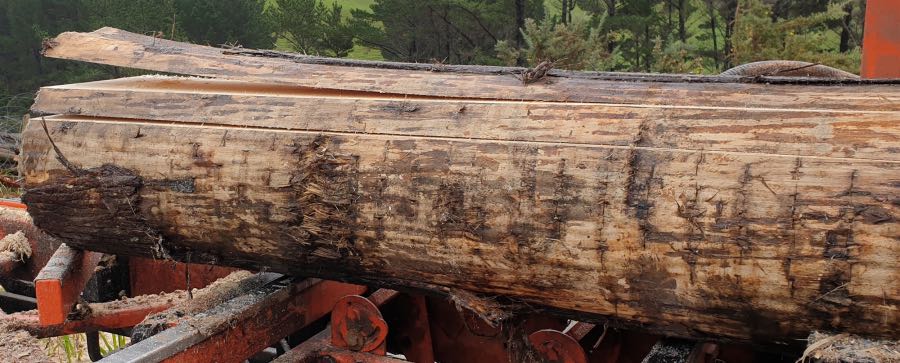
Some bowing occurred during the slabbing process. Weighting the stack of boards in fillet removed most bow.
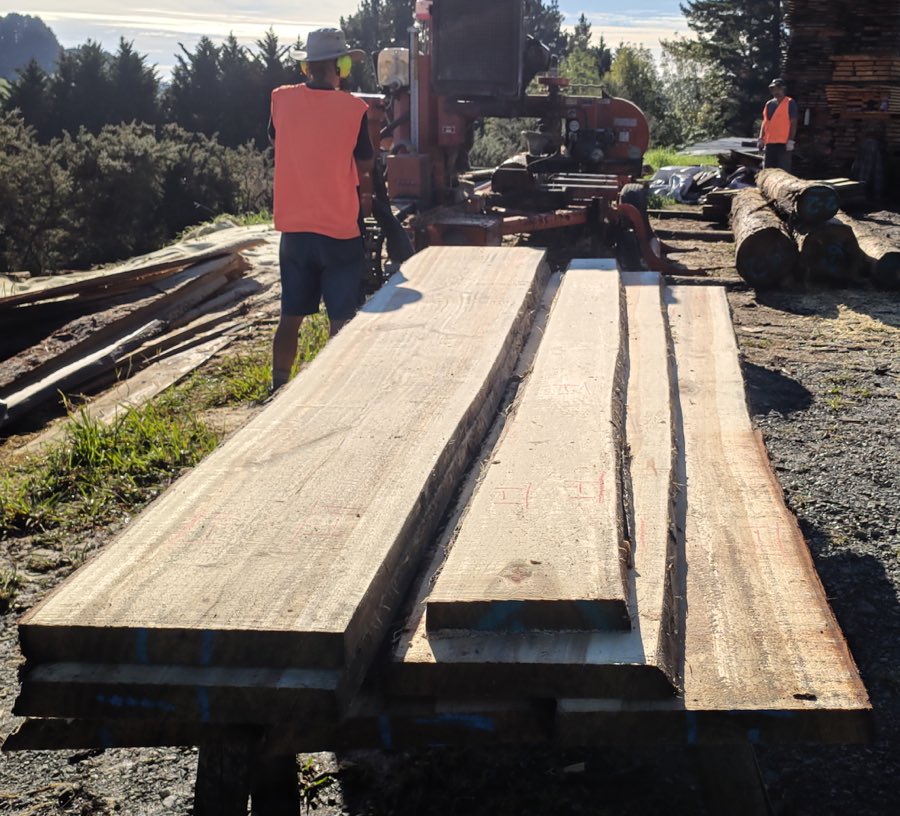
Slabs ready for edging. The slab on the left will be edged into two quartersawn boards whereas the narrower slab to its right will produce one flatsawn board.
Because the pruned logs had a large diameter over stubs (DOS), measured at 25 cm on boards cut through the centre of butt logs, and mechanical debarking caused deep (up to 2 cm) cutting damage, achieving high grade recoveries required significantly higher levels of wastage than would be necessary if mechanical debarking had not occurred and if pruning had controlled DOS to lower levels.
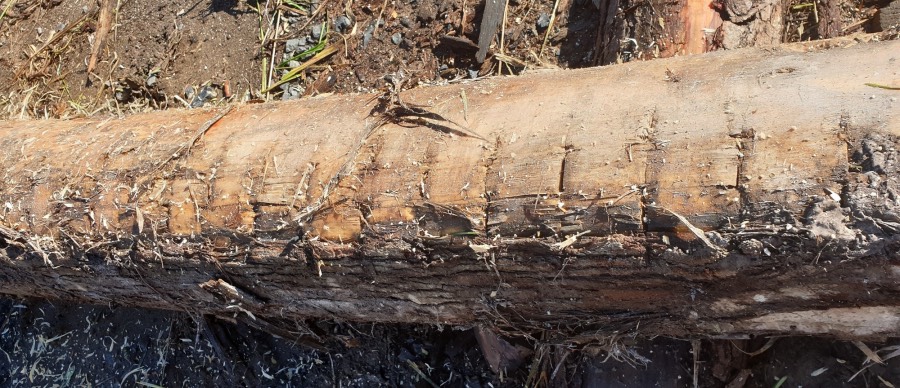
Mechanical debarking caused deep cuts in the log, significantly reducing sawn recoveries. Bruising went even deeper than the cuts, noticeable on the finished sawn product.

Mechanical debarking damage to board. This caused significant loss in sawn recoveries, with some loss in grade recoveries also.
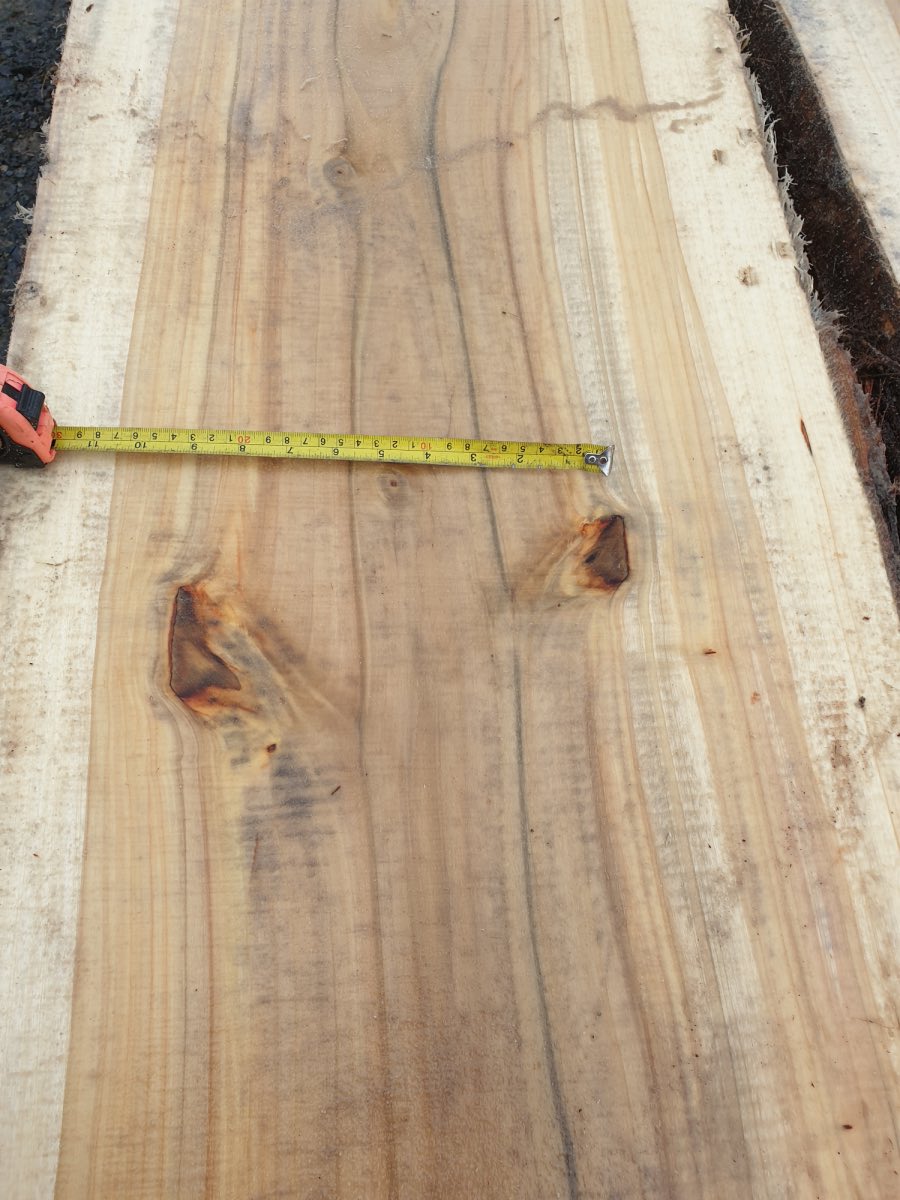
Pruning wounds in a freshly sawn slab. The DOS (diameter over stubs) was measured at 23cm in this slab.

Large pruning wounds combined with mechanical debarking damage caused significant loss in grade recoveries. Growers should endeavour to keep the DOS as small as possible, certainly below 15cm. Poplar should not be mechanically debarked if used for sawn timber production.

Discolouration surrounding pruning wounds.
Sawn timber properties
Strength and stiffness
The modulus of elasticity of ‘Kawa’ poplar structural timber was considerably higher than observed in previous studies of the same clone (i.e., Jones 2016; Wilkinson 2000). The SG10 grade assigned to the No. 1 framing structural timber in this study means that the timber is in a higher strength class than is typically achieved by the main structural timber species in New Zealand, radiata pine (Cown 1999), showing the potential for Kawa poplar to be utilised as a structural timber.
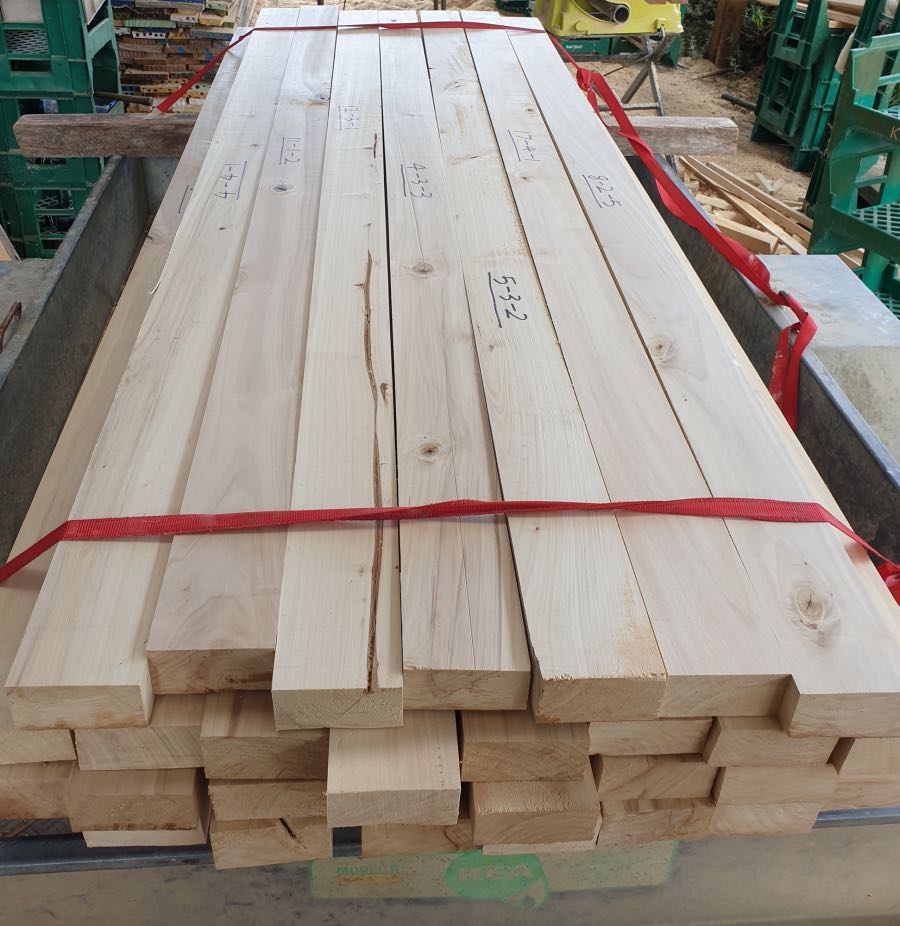
Structural 90x45 samples ready for dispatch to Scion for testing characteristic values.
Glulam made from short clear lengths ("shooks") provides a strong structural appearance product suitable for exposed clearwood beams and rafters. These short clear lengths are a by-product from producing longer lengths of high grades and the 100mm x 25mm Kawa feedstock used for constructing the test beams was from leftover timber after building the poplar cabin. The 79 finger joints in the 32 test beams provided a high quality clearwood finish representative of the frequency of finger joints that could be expected from scaled-up production of larger beams from unpruned Kawa poplar. The lower characteristic strength of the glulam test beams (32.6 MPa) compared with visually graded No. 1 framing Kawa (45.09 MPa) reflects the quantity of finger-joints in the product and should give designers confidence in using it, noting that strength does not limit the grade. GL10 requires a characteristic bending stiffness of 22 MPa, which is not affected by knots and finger joints (D. Gaunt pers. comm), thus grade is limited by stiffness to GL10.
Other sawn timber properties

Wooliness resulting from machine dressing poplar. This can be sanded out. However, keeping cutting knives very sharp should be recognised as a general requirement for high quality appearance products from poplar.
H1.2 boron treatment
Boron diffusion and analysis
The water-based diffusion method worked well, but further work could explore minimum diffusion period to achieve H1.2 specifications, and maximum diffusion period that avoids discolouring the dressed timber, noting that poplar is likely to be used in appearance structural products.

Slight mould formation from being wrapped for diffusion.
Although the boron solution crystalised overnight after use, this could be easily re-warmed to dissolve the boron salts and re-used.
The monoethanolamine treatment worked well but further tests should adjust the quantity of water added, or dip/spray on all four sides. This monoethanolamine solution has the advantage of fast penetration, along with ease of handling (no need to dissolve salts and warm the solution) and is likely to be favoured by processors. Further tests are required.
The boron diffusion process was successful at consistently achieving full cross section penetration and retention to greater than 0.4% BAE. Because NZS 3640:2003 only requires full sapwood penetration and retention to 0.4% BAE, if a method becomes available for determining the heartwood/sapwood boundary in Kawa poplar, then lower concentrations of boron could potentially meet the retention requirements for the standard. This is because the full cross section analysis assumed that the poplar is all sapwood, whereas the H1.2 specification in NZS 3640:2003 only requires 0.4% BAE in the sapwood and the presence of boron is not required in the heartwood. It appears that poplar heartwood is easily diffused with boron because many of the samples had a high heartwood content. Full cross section analysis provides a high level of certainty in respect of poplar heartwood's durability performance until the heartwood boundary can be determined via test methods. Further work is required to devise tests that determine the heartwood /sapwood boundary, in order to reduce the compliance threshold to be equivalent to radiata pine.
Framing trial
The durability performance of H1.2 boron treated ‘Kawa’ poplar used the third-party similar materials test procedure described in the AWPC protocols (Australasian Wood Preservation Committee 2015), with H1.2 radiata pine as the reference preservative/material. Results from the two-year Scion accelerated framing test show durability performance of H1.2 Kawa poplar to be equal to H1.2 radiata pine. This result satisfies the Durability Evaluation section of Clause B2 of the New Zealand building code by providing proof of relative durability performance for H1.2 Kawa poplar being equal to H1.2 radiata pine, an approved material.
Posts
Processing
Posts are essential for a high conversion from logs to products, unless alternatives exist for small diameter, serpentine or short length logs. Although sawn timber was efficiently produced from logs down to 20cm diameter, quarter-round sawn posts were also efficiently produced from logs with diameters between 18cm and 28cm. The optimum log diameter for consistently producing #1 quarter-round posts was between 23 and 27cm. Diameters smaller than 18cm tended to produce #3 quarter-round posts. Log diameters greater than 150mm are also suitable for round strainers and those between 150mm and 175mm could be used for #3 strainers. Diameters less than this could be used for round posts. For the post products this study has explored, log small-end diameters can be as small as 65mm for round #3 fence posts. Viability of round posts will depend on further work on H4 CCA treatment.
One larger log (37cm diameter) proved unsuitable for quartering into posts because the resulting quarter-rounds were too big for use as posts. However, a modified sawmilling pattern could be used to produce slabs from the centre of the log, that would then be edged into boards while also producing four quarter-round posts. Ultimately the sawyer will make judgment calls regarding products to be sawn from different log diameters and shapes, with plenty of scope for producing products deemed to be more valuable.
Timing of the sawmilling revealed that it consistently took 17 minutes to quarter six 1.8m post logs into 24 quarter-round posts, including handling of logs onto the sawmill and posts off the sawmill. This equates to a milling time per quarter-round post of 85 seconds or 0.01167 hour. At a sawmill cost of $200 per hour the sawmilling cost would be $2.33 per post.
Log lengths also dictate what products different diameter logs can be used for. Sometimes the log maker cannot produce a log length suitable for sawing (3.7m) because of limitations such as kinks and forks in the tree. For the products this study has considered, suitable log lengths include 3.7m for sawlogs and posts, 2.4m for strainers and 3.7m/1.8m for round and quarter-round posts.
If consistent penetration and retention results for H4 treatment can be achieved and durability performance tests demonstrate H4 poplar to hold equivalent durability to radiata pine, Kawa poplar posts could hold a competitive advantage as a stronger, superior product to pine.
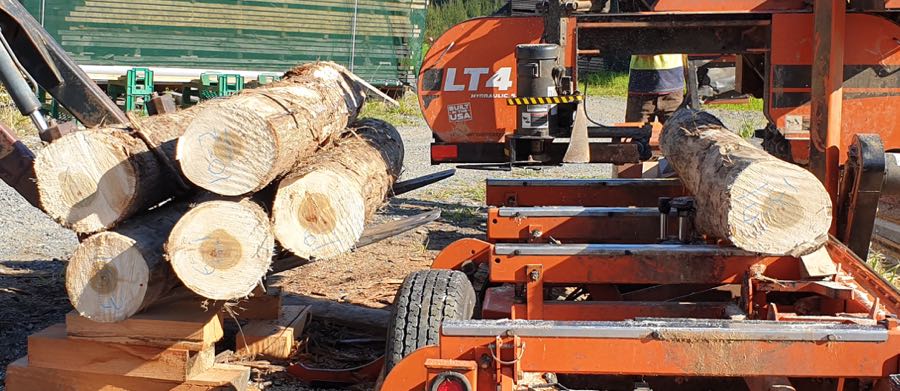
Post logs prior to quartering showing low levels of heartwood.
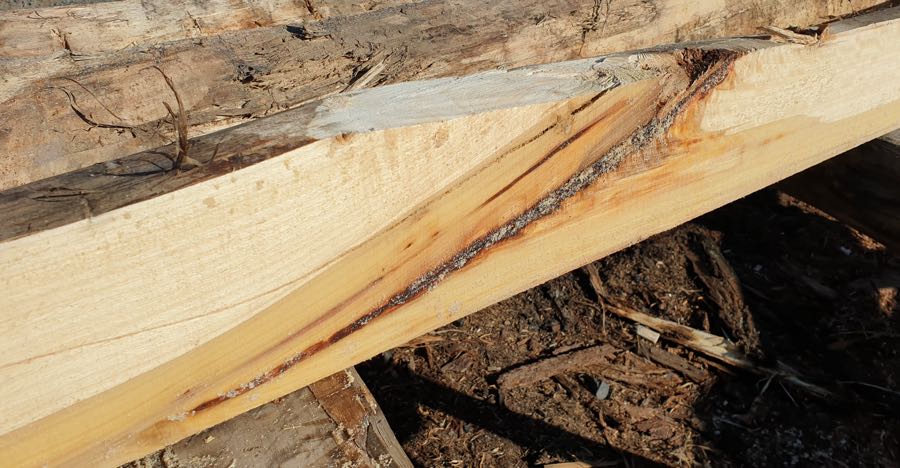
Large spike knots were occasionally encountered with quarter round posts. These were rejected because of weakness but were not common. This contrasts with radiata pine where quarter round posts tend to break easily because of the presence of branch whorls.
Preservative treatment - CCA treated posts
Either sawn dry poplar posts treat better than pre-steamed green* quarter-round posts, or uptake of preservative is faster for green radiata pine in the steam pre-treatment followed by pressure treatment process. Treatment levels were inadequate and inconsistent when green Kawa poplar posts were added to a batch of green radiata pine posts being steamed then pressure treated. This suggests that pre-steamed radiata pine pressure treats faster than pre-steamed Kawa poplar, because preservative uptake for the batch is monitored during the process and once total preservative uptake reaches the required threshold, the pressure is shut down. Batch treatment of poplar would simply require the treatment period to continue until the required uptake of preservative is achieved. A trial batch of poplar should be tested using the steam pre-treatment followed by CCA pressure treatment process, to assess treatment levels and their compliance with the H4 Hazard Class. The length of time required for this to occur would dictate the economic viability of this process. Noting that heartwood appears to be more resistant to penetration than sapwood using this process, both round and quarter round green posts should be compared for preservative uptake under the same schedule.
*green in this context is defined as freshly harvested material that has not dried.
Batch treatment of sawn dry poplar posts is being practiced in the Waikato and other regions, and the results from analysis of fifteen 95mm x 70mm posts suggests that sawn posts with both heartwood and sapwood can be adequately preservative treated with waterborne preservatives. Further work is necessary to verify that larger sizes of posts and strainers meet H4 requirements, along with documenting specific processes used to achieve compliant treatment.
Durability performance trials will also be required before markets are developed, that test longevity of H4 poplar posts.
Post installation and use
Posts rammed well with no breakages (the farmer commented that they "were solid to ram"). The farmer also commented that the posts felt quite dense with a good weight ("similar to pine"), had no splinters, and were solid to staple into with either barbed or unbarbed staples. The posts had splits present in the tops, but this didn't affect ramming and the splits did not open up. The quarter-round posts had a slight curve, but with practice the curve "worked its way in" to produce a straight fence line. Overall, the farmer was very pleased with the posts and he felt they were a superior product to the equivalent radiata posts available on the market.
H3.2 preservative treated poplar
H3.2 CCA 30mm poplar
For the two boards representative of the batch of poplar treated (1 and 2), all 16 samples passed the penetration spot test and the retention analysis. Board 1 (outer heartwood + sapwood) showed a slight increase in retention in sapwood at the end of the board (sample 1e) and to a lesser degree in the full cross section (Figure 13), suggesting that there is slightly higher uptake through the end grain for sapwood.
Board 1 provided higher retentions for sapwood than the full cross section, whereas Board 2 provided higher retentions for full cross section than sapwood. Heartwood in Board 1 was estimated by Ruapehu sawmills to be approximately 50%, whereas Board 2 was supplied as heartwood. Although inconclusive, the heartwood spot test undertaken by IVS Labs estimated the heartwood in board 1 reasonably well, but also appeared to overestimate sapwood in Board 2 (Figure 14). If outer heartwood in Board 2 was tested as sapwood, this could explain the lower retention values for "sapwood" in board 2 than in the full cross section, contrasting with board 1. These results clearly confirm the need for further work on preservative treatment studies in poplar and suggest that inner heartwood may be more easily penetrated with water-based preservatives than outer heartwood, but importantly, heartwood treated well.

Figure 13: Retention according to sample, Board 1

Figure 14: Retention according to sample, Board 2
Board 3 did not treat well, suggesting that inconsistency could be an issue with treating poplar. This board was selected for testing as an "outlier" with the appearance of poor treatment. The board also appeared to have the presence of both heartwood and sapwood, but notably had much closer growth rings and narrower bands of early wood. Clearly penetration was poor, and retention was only adequate in zones well penetrated. Future work could compare preservative treatment of fast grown poplar with wood from stands where diameter growth was slowed by high stocking. Also, importantly, for such work to succeed a reliable heartwood/sapwood test is necessary.
H3.2 CCA 20mm Kawa poplar
In the case of this 20mm H3.2 poplar, full cross section retention was adequate for every board. The patchy penetration was what failed most samples, suggesting further work is necessary to overcome this. Again, being a small sample of poplar added to a batch of radiata pine being treated, the poplar did not treat adequately within the schedule being used. Based on other results in this report, this suggests that radiata pine treats faster than poplar. If this is the case, batches of poplar could be treated effectively under schedules customised for the species. Next steps would be to batch treat poplar to achieve the required uptake of preservative, perhaps on a slower schedule, then test for penetration.
H3.2 MCA Kawa poplar cladding
Retention for copper was quite variable and appeared to correlate with the patchy penetration results. The radiata control from the same batch passed penetration. Again, this could be because of poplar samples treated within a radiata pine batch. Batch treatment of poplar and testing and optimising of schedules could overcome the poor penetration results.
Thermal modification
The thermal modification process used for modifying the Kawa poplar for our trials was an "open kiln" method. The chamber is non-pressurised (except some increases/decreases in pressure by introducing and removing steam) and because an exothermic reaction takes place in the wood being thermally modified, the application of heat is discontinued before the internal temperature of the wood reaches the required threshold. The exothermic reaction continues to generate heat before the wood temperature peaks and the exothermic reaction abates or is controlled by the introduction of steam. Mark Andrew of Tunnicliffe Timber describes the process as "like launching something off a ramp" whereby the final stage is set up by the temperature applied, but is no longer controlled by the continued application of heat. In the case of the Kawa batch, the wood achieved two hours above 230º C, three hours above 225º C and four hours above 220º C.
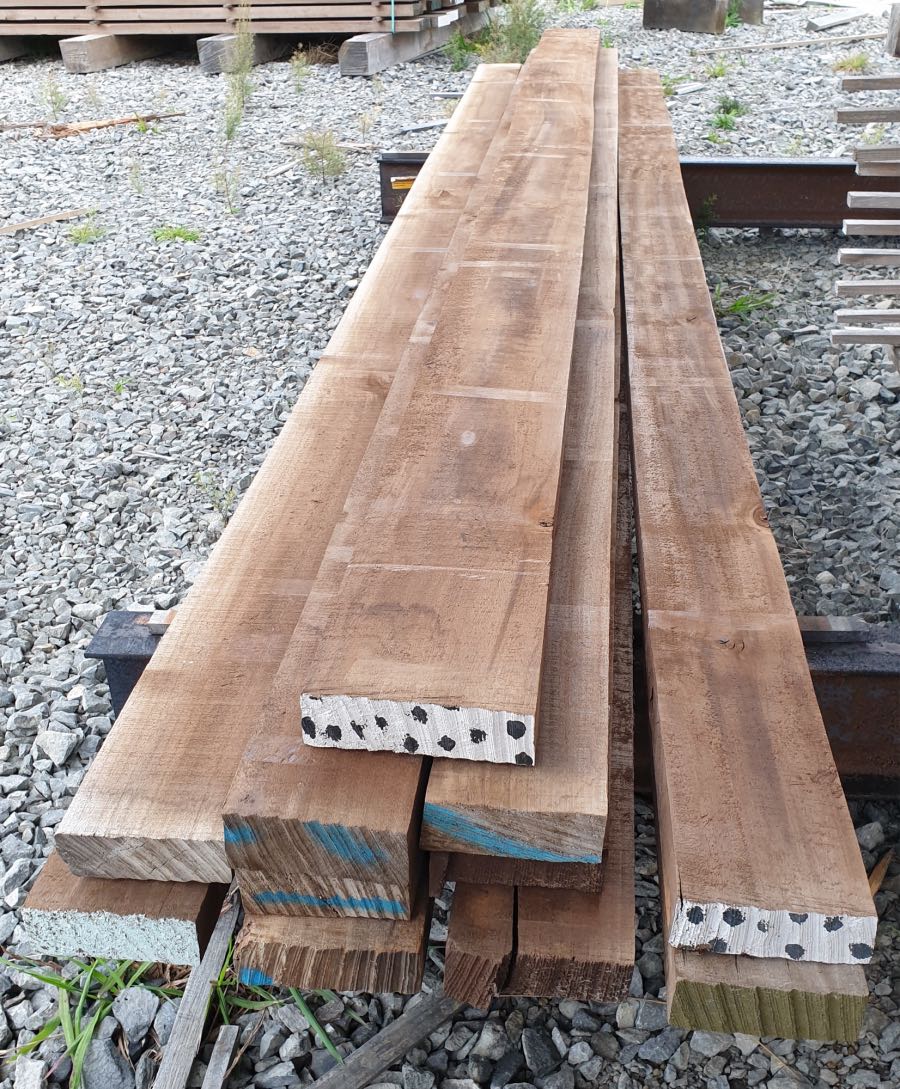
Thermally modified Kawa timber from this study. See more photographs of the thermally modified timber in this study here »
Tunnicliffe Timber have recently invested in closed kiln technology, which is a pressurised autoclave and vacuum system with active control of the internal pressure. The exothermic process is controlled by adjusting the pressure inside the chamber. The required temperature apparently does not need to be as high as required for the open kiln Thermowood 230 product to achieve the same level of durability (M. Andrew, pers. comm). However, durability performance results provided by Mark Andrew for thermally modified timber in New Zealand are for Thermowood 230 modified to 230º C in an open kiln, as per the Kawa poplar timber being trialled.
Because shrinkage and cupping levels were high, it is recommended that poplar boards be oversized well above nominal sizes when sawn. Green-sawn thickness should be no less than 55mm and widths should be oversized 5mm for every 50mm.
Thermally modified cladding
Although the "gold standard" test for durability performance to comply with the NZ building code is demonstrating performance over time in the application itself (e.g. weatherboards) as "history of use", similar materials tests are also available to compare the new material (thermally modified poplar cladding) with an existing material (e.g. thermally modified radiata pine cladding, or macrocarpa/redwood heartwood cladding). If the relative durability exceeds the performance of the existing material, this is evidence under clause B2 of the building code that verifies the product as code-compliant. In the case of the poplar cabin built by Northland Regional Council, a service life of not less than 15 years without degradation is required for the cladding to be code-compliant. Similar materials testing can be faster and could use accelerated decay methods such as "cellar" testing, with a naturally durable cladding species as the control (macrocarpa, redwood, western red cedar are allowed for uncoated cladding in New Zealand under NZS 3602:2003).
The thermally modified poplar weatherboards installed in the NRC poplar cabin were not coated with any product. Timber is often coated with stain, paint or oil to enhance its durability performance. Therefore, testing the durability performance of uncoated timber is the ultimate test of the wood, and if the test timber passes, then so would coated timber. On the other hand, if a coated product were to pass the test, this does not mean an uncoated product passes also.
Because knot checks resulting from the thermal modification process were severe and the resulting wood was no longer of a grade compliant for weatherboards, the poplar wood being thermally modified should either be a clearwood grade, or the resulting knot checks and voids filled with an appropriate filler that does not leak and lasts for a minimum of 15 years. We trialled a Sika product called MS (modified silicon). This was easy to apply and is rated for exterior applications to buildings. Thus, the weatherboard test in the NRC poplar cabin is not just for thermally modified poplar, but also for poplar with voids filled using Sika MS. An Alternative Solution is required for this product to be passed by Building Consent Authorities, thus further work is necessary to prove the filler is both waterproof and remains that way for at least 15 years in exterior cladding exposed to the weather. Thus, the filler product itself also requires evidence of 15 years performance to verify its suitability for filling voids in exposed cladding.
We filled the voids in the final weatherboard product, which had a bandsawn face and proved rather messy. Although the product is easily cleaned up with methylated spirits, on exposure to weather it was evident that not all product had been removed from the face of weatherboards and the appearance was tarnished slightly. Because the weatherboards were produced by bandsawing 50mm thick thermally modified timber through the middle into two boards that were then dressed to a 19mm thickness weatherboard with the bandsawn face exposed, we recommend filling the voids before bandsawing. This would dramatically improve the efficiency with which voids can be filled and would result in a clean finish. Sika MS is very easy to apply and clean up with methylated spirits, so is potentially a cost-efficient and long-lasting weatherproof filler for weatherboards with voids that would otherwise leak.
The thermally modified weatherboards remained very stable during the first summer, whereas the MCA-treated weatherboards cupped. Treated poplar may still be suitable for narrower (ex 150mm) weatherboards, but the thermally modified timber appears suitable for wider (ex 200mm width) cladding because of its exceptional stability in service.
Window and door joinery
The European manufacturing process used by Optimal Windows resulted in a high-quality product that should last the distance. This service test of thermally modified poplar used in this application could "open doors" for a locally produced substitute for the Western Red cedar currently imported from Canada and Northern USA that is becoming increasingly expensive. Only the 15 year in service test can ultimately prove the suitability of thermally modified poplar for this application.
The interior surfaces of window and door frames were oiled, which made them very dark. A water-based polyurethane would provide a more attractive finish on thermally modified timber, with a lighter brown finish and better grain exposure. A polyurethane finish on thermally modified timber should also wear much better and protect the timber from scraping and abrasion.
Structural properties
Although the thermally modified No. 1 Framing grade Kawa poplar failed to achieve characteristic bending strength for SG6 of 10.0 MPa, all 30 samples passed that strength threshold (the lowest was 10.18 MPa). This is because the equation considers coefficient of variation, which was high for the thermally modified Kawa poplar (44.13%) and high strength variation reduces the characteristic value. However, that 9.33 MPa characteristic bending strength for thermally modified Kawa was very close to passing the 10.0 MPa threshold for SG6, and a custom visual grade with less weakness-causing defect, such as a smaller knot size tolerance, would likely pass SG 6 characteristic values. Indeed, the thermally modified Kawa was observed to consistently break at knots and defects, suggesting such a custom grade would easily achieve the 10.0 MPa characteristic strength threshold. If so, this could generate opportunities for untreated structural poplar products.
Decking
Thermally modified Kawa poplar appears to be well suited for decking applications, provided the significantly reduced strength is taken into account by increasing the deck timber thickness or ensuring joist spacing is sufficiently close so that decking will not break under the load from human activity. Certainly, the timber silvers off to the equivalent appearance of hardwood decking, or if oiled the rich colour would be displayed, giving the appearance of a quality hardwood product. However, durability performance testing is required before market development could proceed. The simple option would be for a 15-year test as exterior decking, or alternatively similar materials accelerated decay tests could be undertaken using currently available acceptable solutions for the control, such as Eucalyptus saligna or Cupressus macrocarpa. The leftover shorts from the tests undertaken in this research could be used for a small deck beside the poplar cabin to test the durability performance of thermally modified Kawa poplar for decking.
DMDHEU modification
Mark Fortune reported that two random samples of radiata pine modified in the same batch as the Kawa poplar both achieved 6.8% nitrogen, with 5.9%N and 6.2% N in the central 1/9th section. These samples were both radiata sapwood because previous tests showed that DMDHEU penetration into radiata heartwood was low. All Kawa poplar samples exceeded 3% nitrogen content. The average nitrogen content for Kawa sapwood samples was 3.9% and for heartwood samples 5.5%. Drying and curing of Kawa poplar was successful.
Mark advised that "The current requirement we have for efficacy is a 3% nitrogen content". Therefore all Kawa samples exceeded that threshold, but did not pressure-modify as well as the radiata sapwood. However, given that Kawa heartwood pressure-modified better than sapwood, and all samples exceeded the modification threshold, DMDHEU modification of poplar using standard pressure treatment vessels appears to be viable based on TimTechChem's proprietary modification method. Mark also advised that "It is the drying/curing cycle that makes or breaks the process and is a 7 day cycle from start to finish".
Average % weight gain (after curing/drying) for radiata sapwood was 23% for quarter sawn and 30.7% for wide boards. Average solution uptakes for the pine were 710 l/m3 for quarter sawn and 620 l/m3 for wide boards. Data on weight gain and solution uptake was not available for the Kawa poplar samples. Hardness was not tested in the DMDHEU-modified Kawa poplar, but the samples felt heavier and harder than unmodified Kawa. Mark Fortune reported that "The bulking has also been analysed (in the modified radiata sapwood) and we are seeing a 25-30% increase in density".
Future work could test solution uptake according to length of time under working pressure in the pressure-treatment vessel and the relationship between durability performance and nitrogen content.
Further work could explore the potential for a high quality durable hardwood decking product manufactured from DMDHEU-modified poplar.
Appearance products
The indistinct latewood of poplar and its light colour contrasts with the yellow colour and "tiger stripes" earlywood/latewood bands of radiata pine. This distinctly subtle appearance is reminiscent of native timbers and could be used to advantage in marketing poplar. By using a satin polyurethane coating, the lustre typical of poplar was diminished. A gloss polyurethane would have enhanced the lustre and improved the appearance of the timber's grain.
Flooring
The ex 150mm x 25mm flooring was not sufficiently dry at the time of installation. Shrinkage was observed after the cabin was set up on site at Mata, with cracks appearing between floorboards. The wood had been dried to 10% moisture but was not installed immediately on arrival at the construction site. Construction took place in August 2022 and being winter, ambient moisture levels were high and the wood attained moisture within a few days of storing under cover at the construction site. This suggests that poplar takes up moisture rapidly and poplar flooring timber should be either installed immediately on dispatch/receipt from the kiln, or wrapped carefully in plastic if there will be any delay in installation.
The epoxy coating did not significantly increase the cost of coating the Kawa poplar timber floor. The GemRez epoxy cost $146 incl. gst and made 3 litres of floor coating which should cover 15 square metres. The water based polyurethane cost $219 incl. gst for 4 litres. Each coat of this product was 0.5 litres covering 10 square metres, because this was applied over the epoxy coating which had soaked into the wood and then created an impervious layer. The total cost for the coating products amounted to $20 incl. gst retail per square metre, which would reduce for larger areas.

Kawa poplar floor in the cabin
Residual log value
Of interest to growers are log values. Because there is no existing regional market for Kawa poplar logs, the only option available for now is to estimate log value based on the value of the products yielded, less costs incurred in producing these. This log “residual value” method can then be used to model economic value according to stand size, age and quality.
This report takes the first step towards determining log value for Kawa poplar, by quantifying grade recoveries of sawn product and posts. However, to more accurately estimate log value an economic analysis is required based on market values for the timber products that generate that log value. Ultimately the market would dictate what products produce the highest returns from Kawa poplar and that drive log value. However, until the market for Kawa timber matures, the only available proxy for existing product value is an estimate of timber value based on evidence demonstrating suitability for specific applications. Thus, further research into timber properties is required, including testing of both traditional and new innovative products. This report provides some of the first steps towards determining future log values for poplar.
This would provide the grower with a reasonable estimate of future tree value based on the products that can be derived from that tree, such as sawn timber and roundwood posts, or other products available from the logs. In the context of this research growers will depend on the success of the "best bet" products considered in this report and the introductory literature review.
Disclaimer: The opinions and information provided in this report have been provided in good faith and on the basis that every endeavour has been made to be accurate and not misleading and to exercise reasonable care, skill and judgement in providing such opinions and information. The Author and NZFFA will not be responsible if information is inaccurate or not up to date, nor will we be responsible if you use or rely on the information in any way.

 Farm Forestry New Zealand
Farm Forestry New Zealand